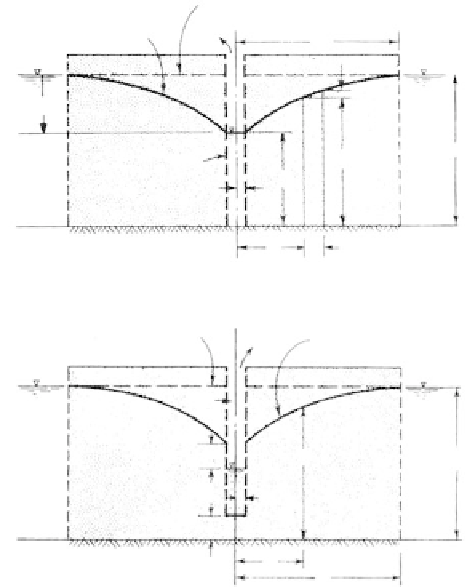Environmental Engineering Reference
In-Depth Information
Initial phreatic surface
Phreatic surface
during pumping
Q
w
R
dh
Drawdown
H
Well
h
Sands
h
w
r
w
(a)
r
dr
Phreatic surface
during pumping
Initial phreatic surface
Q
w
Well
FIGURE 8.31
Flow to a gravity well from an unconfined
aquifer providing circular seepage source:
(a) fully penetrating well and (b) partially
penetrating well (also gives the height of
free discharge
h
' to be accounted for in
computations in either case). (From Mansur,
C.I. and Kaufman, R.I.,
Foundation
Engineering,
G.A. Leonards, 1962.)
h
′
h
H
Sands
t
r
w
s
r
(b)
R
During pumping a number of hydraulic observations are possible, on the assumption
that the cone of depression is not influenced by other wells:
1.
Yield
, the quantity of water pumped per unit of time (gal/min, L/min. etc.) can
be measured to provide a quantitative amount for the well yield without consid-
eration of draw down or well size.
2.
Drawdown
during a selected period of pumping can be measured. If the pump-
ing level becomes stationary after a period of pumping, the natural groundwater
supply to the cone of depression is equal to the quantity pumped, thereby pro-
viding information on the supply available. The drawdown necessary to pro-
duce the water pumped is a direct function of the permeability of the
water-producing stratum, and the permeability of the aquifer supplying a num-
ber of wells can be determined from the drawdown of the respective wells, pro-
vided that frictional resistances caused by well screens and filters into the
various wells are equal.
3.
Specific capacity
(gal/ft of drawdown) can be calculated. It provides the best
measure for comparison of yield between two or more wells, and depends on the
permeability and the thickness of the aquifer (transmissibility), and the frictional
resistance at the well entrance.
4.
Overpumping
of an aquifer is indicated if the water level does not rise to its orig-
inal level after pumping is stopped.
5.
Safe yield
is indicated if the recovery between pumping periods is complete.
6.
Rate of recovery
depends on, and subsequently indicates, the permeability of the sur-
rounding aquifer. It can be determined by means of an electric probe lowered into
the well to measure the rise in the water level as a function of time (see
Section 2.3.7).



